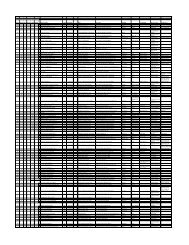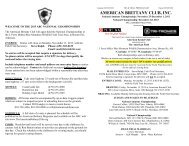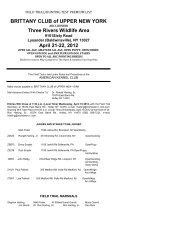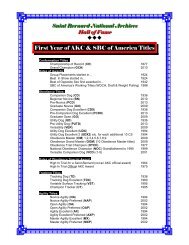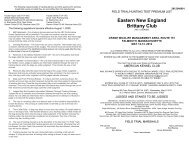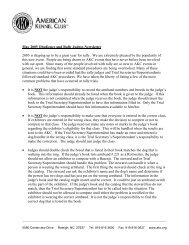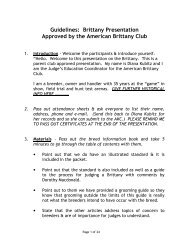The Skye Terrier - National Breed Clubs - American Kennel Club
The Skye Terrier - National Breed Clubs - American Kennel Club
The Skye Terrier - National Breed Clubs - American Kennel Club
You also want an ePaper? Increase the reach of your titles
YUMPU automatically turns print PDFs into web optimized ePapers that Google loves.
It was this dog’s duty to follow the scent of vermin, and then, by squeezing<br />
through narrow spaces, balancing upon ledges, and leaping from<br />
rock to rock, to guide his master toward their quarry– often fox, badger,<br />
otter or weasel. <strong>The</strong> terrier cornered and fought the vermin alone,<br />
sometimes underground, unseen and unaided.<br />
So great was this little dog’s courage<br />
and tenacity of purpose that the prey inevitably<br />
found itself outmaneuvered. Thus the<br />
‘Highland Working <strong>Terrier</strong>’ earned both his<br />
keep and the respect of the tough Highlanders<br />
as well.<br />
<strong>The</strong>se scrappy little dogs had thick, hard,<br />
rather long and shaggy, weather resistant<br />
double coats, and are thought by some to<br />
be, if not the actual dogs, at least the ancestors<br />
of many of the Scottish terrier breeds.<br />
At least four breeds are directly descended<br />
from him: the Aberdeen <strong>Terrier</strong>, now known<br />
as the Scottish <strong>Terrier</strong>; the West Highland<br />
White; the <strong>Skye</strong> <strong>Terrier</strong>; and the now extinct<br />
Ryle.<br />
It is interesting to note how the climate of Scotland and the Scottish<br />
Isles is reflected in the coat of the <strong>Skye</strong>. <strong>The</strong> need for protection from<br />
the cold and wet resulted in an outer covering of hair and an inner<br />
coat of short wool. <strong>The</strong> advantage of the outer coat is to throw off the<br />
rain and sleet, while the inner coat, while excluding wet, also provides<br />
warmth. <strong>The</strong> coat of the <strong>Skye</strong> was also a coat of armor, providing some<br />
semblance of protection from the teeth of the adversaries.<br />
Because the chief end of his existence was to go to ground, the <strong>Skye</strong><br />
was bred with short legs. In fact, the <strong>Skye</strong> is the longest and lowest of<br />
all terriers, and is therefore better adapted to do the work of a terrier<br />
than any other. <strong>The</strong> advantage of going to ground with a shortlegged<br />
dog over a longer legged one is that shorter legs allow the former to<br />
work in a natural position, while the latter must crouch and thus, lose<br />
power. <strong>The</strong> <strong>Skye</strong>’s long, low body is the heritage of the functions of the<br />
early breeding of the animal.<br />
Not to be overlooked, of course, is strength. <strong>The</strong> flexible body of the<br />
<strong>Skye</strong> is complemented by a head of imposing strength and unlimited<br />
holding and punishing power. It should be noted that this is a distinctive<br />
feature of all of the north country terriers, since a dog with a strong<br />
head could effectively block a predator’s escape from den or burrow.<br />
page 4<br />
<strong>Skye</strong> <strong>Terrier</strong> <strong>Club</strong> of America






